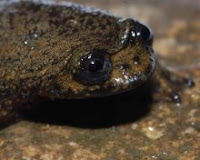Harvard biologist David Blachurn knew he was onto something unusual when a benign-looking frog he was examining in Cameroon, West Africa kicked out and left him with a bleeding cut. Unusual indeed – an article (23 August 2008) in Biology Letters describes the hidden claws of Perret’s night frog as the only vertebrate claws known to break through the skin in order to become functional. Some, or possibly all, of the other 10 frogs within the genus Astylosternus are also equipped with skin-covered claws on their toes (the fingers are clawless).
 The frog’s sharp, curved claw is actually the last bone of the toe, and pierces the toe’s skin when a specific tendon is flexed. It is assumed that the claw retracts after use and the skin heals, but further study is needed. Other amphibians that experience “self-inflicted” wounds include the Surinam toads, Pipa spp., whose young push through the skin of the female’s back when ready to swim off on their own and the ribbed newt, Pleurodeles waltl. The ribs of this newt pierce the skin of the back, carrying toxins with them, when the animal is threatened.
The frog’s sharp, curved claw is actually the last bone of the toe, and pierces the toe’s skin when a specific tendon is flexed. It is assumed that the claw retracts after use and the skin heals, but further study is needed. Other amphibians that experience “self-inflicted” wounds include the Surinam toads, Pipa spp., whose young push through the skin of the female’s back when ready to swim off on their own and the ribbed newt, Pleurodeles waltl. The ribs of this newt pierce the skin of the back, carrying toxins with them, when the animal is threatened.
Despite the massive trauma caused by the emergence of 80+ fully formed little frogs, the skin of breeding Surinam toads (P. pipa) under my care appeared well-healed within 24 hours. I’m sure there are some compounds that may be of medical use to people hidden in the body chemistry of this and other amphibian species.
Of course, people living within the habitat of Perret’s night frog have long known of its odd defense and even utilize specially-constructed spears when hunting it, to avoid being injured.
The only other frogs known to have claws are members of the family Pipidae – the various African clawed and dwarf African clawed frogs. I have observed both putting their claws, which are always exposed, to interesting uses (more to come in future articles).
You can read more about this frog and related species at:
http://research.amnh.org/herpetology/amphibia/references.php?id=1191
 That Reptile Blog – Reptile, Amphibian and Exotic Pet Care and Information
That Reptile Blog – Reptile, Amphibian and Exotic Pet Care and Information

 An article to be published later this month (Zootaxa; August, 2008) will announce that a newly described Thread Snake from the Caribbean island of Barbados is the smallest of the world’s 3,100+ snake species. The Barbados Thread Snake grows to a mere 4 inches in length, is no thicker than a strand of spaghetti, and can coil comfortably atop a quarter. It subsists largely upon ant and termite larvae, and may be threatened by habitat loss. A relatively large hatchling – ½ of the adult size – emerges from the single egg laid by the female (perhaps there is no prey species tiny enough to support a larger brood of smaller-sized young).
An article to be published later this month (Zootaxa; August, 2008) will announce that a newly described Thread Snake from the Caribbean island of Barbados is the smallest of the world’s 3,100+ snake species. The Barbados Thread Snake grows to a mere 4 inches in length, is no thicker than a strand of spaghetti, and can coil comfortably atop a quarter. It subsists largely upon ant and termite larvae, and may be threatened by habitat loss. A relatively large hatchling – ½ of the adult size – emerges from the single egg laid by the female (perhaps there is no prey species tiny enough to support a larger brood of smaller-sized young).